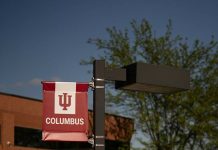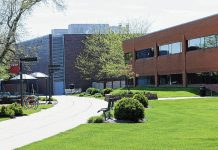A major overhaul of traffic patterns in downtown Columbus is now fully on the road to becoming a reality.
City Board of Works members gave unanimous approval Tuesday to three changes along Second, Brown and Jackson streets, following the recommendation of the city engineering office and Cummins Inc.
Cummins recently commissioned a downtown traffic study after its employees in its seven downtown buildings reported an increase in the number of near collisions with passing vehicles. As a result, the local manufacturer proposed changes to the three heavily traveled downtown streets in an effort to increase pedestrian visibility and safety.
The first change the Board of Works approved will allow for installation of new traffic signals and pavement striping at the intersection of Second and Brown streets.
Last month, the Columbus City Council approved an ordinance change to allow a portion of Second Street outside of the Second Street parking garage to be converted from one-way traffic to two-way.
Currently, all traffic that leaves the parking garage is required to turn left and head east, forcing drivers who want to travel west out of town to circle around the block of Second, Jackson and Third streets, Julie del Genio, a Cummins employee working on the traffic project, toward Board of Works members on Tuesday.
Although the parking garage is predominantly occupied by tenants in The Cole apartment complex, Cummins has 500 spots reserved in the garage for its employees, del Genio said.
The council’s approval of the switch to two-way traffic on that portion of Second Street allowed the engineering department to begin designing plans to install new traffic signals and pavement striping, and those plans required Board of Works approval, said Dave Hayward, executive director of public works/city engineer.
Cummins also is working with the Columbus Redevelopment Commission to get the proper approval for changes that must be made inside the garage to facilitate the new right-turn lane, Hayward said.
The Board of Works’ approval also will allow for several changes to Brown and Jackson streets.
Right now, three lanes run through the five blocks of Brown between Third and Eighth streets, but Cummins has proposed reducing those blocks to two lanes, del Genio said.
The traffic plan also called for the speed limit along Brown Street to be reduced from 35 miles per hour, but the reduction in the number of lanes likely will bring the speed limit down naturally, Hayward said.
Additionally, two of the three mid-block crosswalks between Fifth and Eighth streets on Brown will be removed as a way of encouraging pedestrians to cross the street at an intersection, rather than in the middle of the road, del Genio said.
The remaining mid-block crossing will be accompanied by a HAWK — high-intensity pedestrian activated walk — signal leading into the west security entrance of the Cummins Corporate Office Building, which backs up to Brown.
Another new traffic signal known as a rectangular rapid flashing beacon will be installed at the intersection of Brown and Fourth streets. Unlike a HAWK signal, which requires traffic to come to a complete stop for pedestrians, a flashing beacon serves as a warning to drivers that pedestrians are nearby, Hayward said. A flashing beacon is currently used along Central Avenue near Parkside Elementary School.
Jackson Street’s changes also will focus on pedestrian crosswalks, del Genio said.
Crosswalks will be added at the intersections of Sixth and Seventh streets leading out of the parking garages in those areas. Additionally, the curb will be extended and bumped out at the new crosswalks on the west side of the street that runs along the front entrance of the corporate office building.
Right now, the west side of Jackson is filled with angled parking spots that limit pedestrian visibility, del Genio said. About eight parking spots will be lost when the curbs are bumped out, she said, but the loss of the spaces will lead to an increase in pedestrian safety.
Finally, Board of Works members approved an agreement that will allow Cummins to install fencing along the Brown Street sidewalks. The fencing, along with some low-level landscaping, will be used to discourage pedestrians from crossing in the middle of the street and instead direct them to crosswalks at intersections, del Genio said.
The 36-inch-high fencing will be located in the city’s right of way, which is why the measure required Board of Works approval, Hayward said.
Evidence of the downtown traffic changes likely will become evident in the mid- to- late summer months, Hayward said. However, Phil Henry, another Cummins employee working on the traffic overhaul, said the project could possibly carry into next year before it is completed.
List of changes
The Columbus City Council gave approval last month to an ordinance change that allows a portion of Second Street outside of the Second Street parking garage from one-way traffic to two-way. The change will allow drivers exiting the garage to turn left or right out of the garage, cutting down on back-ups in the Second-Jackson-Third streets block.
Changes approved by the Board of Works on Tuesday include:
Approval of plans for new traffic signals, pavement striping and curb work at the intersection of Second and Brown
Reduction of lanes along Brown Street
Installation of HAWK, rectangular rapid flashing beacon on Brown Street
Installation of new crosswalk at intersection of Jackson and Sixth, Seventh streets
Curb bump out at intersection of Jackson and Sixth, Seventh streets
Use of city right of way to install fencing along Brown Street




